 |
Lancaster County--1867 |
This is a NEGenWeb Project web page
and is presented as part of the
MARDOS Memorial Library Collection.
Lancaster County--1867
|
The rural communities in Lancaster County, in the southwestern part are an overflow from Saline County, the first settlers coming there soon after the first came to Saline. 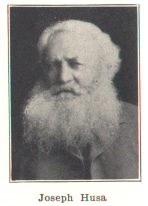
The first to come, as far as is known, was Frank Husa, born in Dobrejice near Hluboka, who took a homestead here in 1867. Two years later his brother Joseph, also born in Dobrejice, came with family. Mrs. Marie Schlajs, daughter of Joseph Husa, writes: "My uncle Frank Husa came to Nebraska in 1867. He went afoot from Nebraska City to Crete and took a homestead two miles east of Crete, near the western boundary of Lancaster County, taking at the same time one for my father Joseph Husa. But my father was obliged to stay in Bohemia until he had sold his property there, which meant two years' time. We arrived in Chicago July 4th, 1869, my parents, my brothers Jacob and John, my sister Anna (Mrs. Janecek) and I. As we were coming away from the depot, I carried my brother John (now living near Gilead, Thayer County, Nebraska) on my back. A bit of fireworks fell on my hand, burning it so that we were obliged to stay in Chicago two weeks longer." Later these brothers moved to Gage County near Barneston, when the Indian reservation was opened to whites in the early eighties. Frank Husa died about 1907, Joseph Husa about 1918. 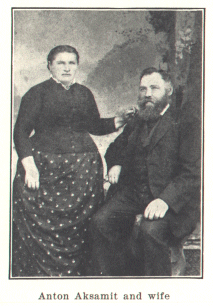
In April 1870--The Following Came: Matej Pomajzl and sons Frank and Joseph, Oubenice, Unhost; Vaclav Stehlik, Jihlava, and his father-in-law Jirman; Frank Smid with sons Joseph, Frank, Vaclav and John, Sobredraz, Orlik; Frank Pavlik, Stechovice, Strakonice; Matej and Joseph Jirotka, Velke Pritocno, Unhost; Anton Aksamit, Pavlov, Unhost; Joseph Janecek with son Martin, Dolany, Klatovy; Joseph Josifek, Vamberk, Rychnov nad Kneznou; John Sindelar, Kvetov, Milevsko. 1871--The Following Came: Matej Vancura, from Cleveland, Ohio; Matej Kotmel, Laziste. 1873--The Following Came: Joseph and Vaclav Letak, from near Zbraslav. 1874--The Following Came: Vaclav Machacek, Lhota, Sobeslav, Tabor; Joseph Prochazka, Kucer, Milevsko. 1875--The Following Came: Vaclav Vetrovec, Ujezd, Unhost. 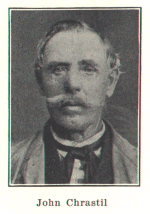
Karel Helcl (called Hercl) with his wife Antonia, from Unhost near Praha. The Helcls came to Mrs. Helcl's sister, Mrs. Joseph Letak. Letaks lived in a dug-out near Hallam and there they spent their first night in Nebraska. In the morning, when it seemed time to get up, darkness reigned, so Mrs. Helcl thought: "What long nights they have in America." At last she arose and looked at the clock, and as it was nine, she inquired the reason for the darkness. It has snowed quietly but heavily all night and the dug-out was completely covered. They forced a pathway by pushing a dishpan out of the doorway through the snow. Helcls bought 80 acres and later another farm of 160 near the center of the county, where they farmed until 1889, when they retired to live in Crete. Mr. Helcl died in 1905, his wife in 1926. 1876--The Following Came: Joseph Svancara, Ujezd, Unhost; Joseph Kozel, unknown; Mr. Maranek, unknown; Frank Trousil, Racice, Beroun; Joseph Tyser, Racice, Nove Straseci. 1877--The Following Came: Frank Rejcha, Belejsov, Klatovy. Pioneers, whose date of coming is not certain: Anton Kotmel, Laziste, Cmel; Frank Kozeluh, Hyskov, Beroun; Frank Stipek, Hyskov, Beroun; Matej Korbel, Radimov, Sobeslav; Fr. Sticka, Konojedy, Cerny Kostelec; Joseph Vavra with sons Frank, Anton and Joseph, Mirosovice; Alois Jiskra, Krivoklat; Frank Chrastil, Mirosovice; John Chrastil and son Joseph, Mirosovice; John Dunder. Hostoun, Unhost; Joseph Kubes, Voseka, Milevsko; John Bajer, Stare Benatky, Nove Benatky; Fr. Kuzelka, Meceriz, Nove Benatky; Joseph Salda, Vysoka. These and others settled in the vicinity of Kramer, Denton, Hallam, Highland and Sprague, some had postoffice in Crete or Wilber. As an illustration of pioneer hardship, we give the following: In the early seventies Frank Chrastil settled on his homestead in the southwestern corner of Lancaster County, with his wife and two small children. Later, when his wife became ill, Chrastil went for the doctor afoot to Crete, the nearest town, eleven miles distant. He had only oxen and they would not have made greater headway. The night was stormy, he lost his way, the rain came down in torrents. He was obliged to await the dawn, before he could continue on his way and get the doctor, so sorely needed. A few miles northwest of Chrastils lived the family of Joseph Vavra. Old Mrs. Vavra had raised Mrs. Chrastil as her own child, she having been an orphan. Mrs. Vavra was known far and wide for her kindly services to homesteaders and when later Mrs. Chrastil died and there was no one to perform the burial service, she herself spoke a few words of comfort at the grave. The early-day funerals were simple, unostentatious affairs, but the sympathy and helpfulness of the pioneers made up for that. The women brought flowers from their little gardens, to garland the coffins. All pioneers feared Indians, but those fresh from Europe doubly so. When news came to Lancaster County of the killing by Indians in Kansas of several Czechs who were known to the Czech pioneers there, it produced a sensation. People were afraid to venture forth and asked each other daily if they had not seen Indians about. About September 14, 1878 a group of Northern Cheyenne Indians raided the state of Kansas. Crossing the boundary near the southeastern corner of Comanche County, they divided into smaller groups and attacked cattlemen along their way, in Barbour, Comanche, Clark, Meade, Ford and Foote counties. They murdered many and wounded more, among them children and women, and slaughtered their stock. In some cases they drove stock away, after killing enough for their needs. In others they shot the animals out of pure wantonness and love for killing. Their wives and children shot arrows at cattle and drove sheep to water, where they held their heads under until they perished. They stole horses, food supplies, clothing, and whatever they could carry away, destroying the rest. 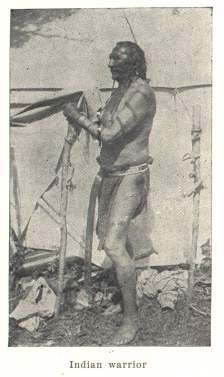
When the Indians crossed the Arkansas river, near Cimarron, in Foote County, they proceeded almost due north, through the western part of Hodgman and Ness Counties, but did not do much damage. Crossing the Kansas Pacific railway near Buffalo, they approached the settlements in Sheridan, Decatur and Rawlins Counties. These were inhabited mainly by industrious and peaceful Czechs, but the Indians continued in their cruel methods. They stole or killed stock, destroyed homes and furniture, filled wells with killed poultry, murdered men and raped women. Some of the settlers fled to woods and ravines, where they hid for days without shelter, food, water and even without clothing. One boy who had been wounded escaped with only the shirt on his back. On October 1, 1878, as the sun was rising, they appeared in the vicinity of Ludell in Rawlins County. The night before entering this valley, where lived about seven Czech homesteaders, they had killed about fourteen head of cattle. The settlement was situated in the beautiful Beaver Creek valley and began on the east with the farm of Hynek (Ignac) Janousek and terminated four miles further west with the farm of Anton Bouda. It was on Bouda's farm that the Indians commenced their work, just as the owner was breakfasting. He stepped out and saw that several Indians were leading away his horses. Thinking they were horse thieves, he threatened them by word and gun and inasmuch as his horses were old, the Indians let them go and departed. From Bouda's farm they proceeded to the farm of Frank Spevacek, where they were met by Frank Sochor, the aged father of Mrs. Spevacek. The old man, thinking they wanted food, came out of the house carrying several loaves of bread, but they shot him dead and ravaged the farm, culminating their work by driving a hatchet into the old man's skull and scalping him. Spevacek was not at home at the time. Several Czechs lived in the settlement who had moved there from Saline County, when they had friends and relatives. They were Hynek, Pavel and Peter (brothers) Janousek; Rudolph Springler, whose wife was Janouseks' sister; Frank Vocasek, whose wife was a sister of Lancaster and Saline County pioneers, the Aksamit brothers. A daughter of another sister of the Janouseks married Joseph Znamenacek, of Saline County. The Janousek brothers came to America soon after 1874, their birthplace being Velka Kysice near Unhost. Hynek Janousek (also called Nacek) came with his wife and children. He had owned a cottage and some tillable ground in Hate near Kladno. Pavel (Paul) came with a large family. Peter left a wife and five small children in Hate near Kladno, where he had property. His wife stayed behind to sell it, but when she received word of his death, she remained there. Rudolph Springler was born in Uuhost, and came with wife and ten-year-old son. He was a carpenter in Bustehrad near Kladno. 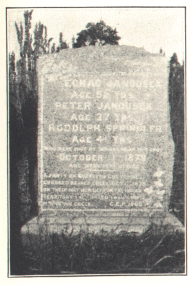
When these settlers heard of the Indian raids, they gathered at Hynek Janousek's farm. Frank Vocasek had gone to the mill in Norton, Kansas, 75 miles distant, so his wife and children went to Janousek's too. Before long Indians appeared on Springler's farm, but as there was no one there, they sent a scout to the farm of Hynek Janousek. This scout made signs for the people to come out, so the frightened men emerged with unloaded guns, intending only to scare the Indians away. There were but three of the latter and three white men faced their captors. Each Indian grasped the hand of his prey with the words: "Hau, hau", and in the next instant each shot his victim to death. Hynek Janousek had taken his year-and-a-half-old son Charles in his arms when he came out, thinking the child would move the Indians to have mercy. The bullet that passed through his brain glanced off from the child's forehead, but did not harm him. However, Charles Jauousek carries the mark to this day. The child's mother quickly picked it up and fled with the rest to cover. (picture caption follows:)
The Indians completed their devastation by shooting stock, stealing horses and whatever they could use from the house. They cut the featherbeds and took the slips. Vocasek was postmaster, so they stole money and stamps and whatever they found in his home. All he had left were the horses he had gone to mill with. That same day these Indians killed eight other settlers. 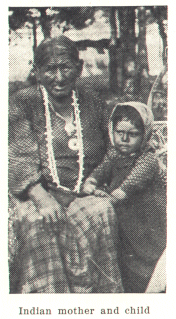
The wives of Hynek Janousek, Rudolf Springler, Frank Vocasek, Anton Bouda and Paul (Pavel) Janousek hid for several days on the farm of a Hungarian settler. Paul Janousek at the time was working for Frank Jelinek near Crete, Saline County. His wife, on the morning of the tragedy, was about a mile distant, picking corn. The Indians pulled the kerchief off her head and then wanted to take the sack into which she was putting corn, for they thought she had something valuable in it. At that moment, however, they caught sight of a settler named Cubits and pursued him, killing him. The same fate met a Fred Hemper, near Beaver creek, Mrs. Janousek being an unwilling witness of the horrors. Her young son was with her, so she sent him to the neighbors for help, but he returned with the dreadful news, which so stunned her that she forgot her children at home and ran to meet her friends. However, later she set out to meet Vocasek, hoping for his return and met him shortly. News of the tragedy was sent to Paul Janousek, who immediately came and with him a Mr. Znamenacek of Saline County. The survivors intended to move away at once, but Janousek and Znamenacek gave them fresh courage. Spevacek and Bouda had buried the bodies, with the aid of American neighbors. In 1900 a marker was erected to their memory. (Illustration and inscription on page l33). Almost two days elapsed before the vicinity was cleared of the last Indian and Paul Janousek's children, in their home all that time, were found unharmed. A day later the soldiers came, but did not act with energy. Old Mr. Sochor left a wife, Mary, and a daughter Mrs. Barbara Spevacek. Mary Sochor, Mary Janousek, Paul Janousek, Frank Vocasek and Frank Spevacek requested the government to pay damages for the losses they sustained and these were paid in part. Vocasek was in fair circumstances for those times. At one period he owned a mill. Later he moved to Petersburg, Virginia, at present he lives in South Omaha, Nebraska. Spevacek later moved to Oklahoma and Bouda to Ord, Nebraska. The widows of Hynek Janousek and Rudolph Springler married again. Paul Janousek and family stayed in Kansas, where they lived to a good old age, after a lifetime of hard work. Their sons and daughters still live in that vicinity. The merry intertwines with the sad in this life and so even this tragedy had a comical reverberation in Lancaster County. Mr. Frank Rejcha, a pioneer there, now living in Wilber, tells about it, for it happened in the home of his relative: "My father-in-law John Chrastil sat one evening at supper with his family in his little shanty, when they heard shots in the distance. Mrs. Chrastil cried out: "Heaven help us, the Indians are coming!" Chrastil owned a large, fierce dog, but the animal, upon hearing the shooting, began to howl and scratch on the door, trying to get inside. That only intensified the excitement, for Chrastils thought the savages were in sight. Chrastil opened the door a bit, meaning to set the dog upon the Indians, but he ran into the house and crept under the bed. Chrastil pulled him out, the dog howled and resisted, the shooting re-commenced louder than before. Mrs. Chrastil knelt down with the children, to pray for mercy, and Chrastil wept to think they had come to America only to be killed by Indians. Chaos reigned broken at last by the sounds of an accordion. So Chrastil gathered courage and stepped out, for he had never heard that Indians could play the accordion. He found that the pandemonium had been caused by his German neighbors, who had thus been celebrating the New Year, going from farm to farm to wish each neighbor a Happy New Year!" Frank Chrastil, who had been visiting his brother John one winter night, set out for his farm four miles distant, when he was overtaken by a blizzard. He lost his way, so sat down and waited until daylight, when he found that he was resting right next to his house. Although Czechs have lived here since about 1867, it was not possible to obtain names of the first comers. 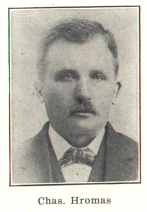
1874--The Following Were Living Here: Louis Hromas, carpenter, his brother Charles, a boiler maker, and their mother, -- all from County Caslav; Joseph Kokes, saloonkeeper; Frank Kokes, a cigar maker; Frank Vosika, tailor and musician, born Rosec, Jindrichuv Hradec; Joseph Kubanek, mason, Skrchleby, Nymburk; Anton Proskovec, stone cutter, later lived in Butler County; Albert Mudra, harness maker, Sobesice, Zbirov; John Suler, grocery, Jindrichuv Hradec; Joseph Danek, laborer, Krouna, Skutec. 1876--The Following Came: Fr. Friauf, laborer, Cekov, Zbirov; Anton Caslavsky, tailor, Chroustovice, Chrudim; Fr. Hotovec, mason, Sokolec, Podebrady; Mike Cizek, mason, Hostomice, Caslav; Fr. Splichal, mason, Moravske Budejovice; Fr. Straka, butcher, Zd'ar, Jihlava. 1878--The Following Came: Martin Soukup, Cekov, Zbirov; Vaclav Soukup, laborer, Cekov, Zbirov; Joseph Vidlak, painter, Votesice, Habry; Vaclav Kucera, tailor, Stritice, Chotebor. 1883--The Following Came: Ignac Stastny, tailor, Ratkov, Morava; Vaclav Hotovec, laborer, Sokolec, Podebrady. An interesting Czech inhabitant of Lincoln was John Vozab, who lived with his wife in his son's (John J. Vozab Jr.) home. He came to Manitowoc, Wis. as a nine-year-old boy with his parents in 1849, having been born in Lesany near Velvary August 20, 1840. In 1862 he married Mary Senfeld (Schoenfeld) who was born September 1841 in Citov near Melnik, and came with her parents to Manitowoc in 1857. In 1869 they came to Saline County, near Wilber, in 1880 moved to Wymore, in later years lived with their daughter in Ord, then with the son, where in May 1926 they celebrated the 64th anniversary of their wedding day. Now living in Wilber. |
| Back | Table of Contents | Next |